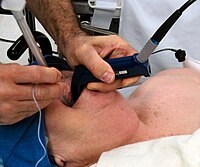
Photo from wikipedia
OBJECTIVE Aerosol-generating procedures, including endoscopic endonasal surgery (EES), are a major risk for physicians during the COVID-19 pandemic. Techniques for reducing aerosolization and risk of transmission of COVID-19 during these… Click to show full abstract
OBJECTIVE Aerosol-generating procedures, including endoscopic endonasal surgery (EES), are a major risk for physicians during the COVID-19 pandemic. Techniques for reducing aerosolization and risk of transmission of COVID-19 during these procedures would be valuable to the neurosurgical community. The authors aimed to simulate the generation of small-particle aerosols during EES and craniectomy in order to develop methods to reduce the spread of aerosolized particles, and to test the effectiveness of these methods. METHODS This study was performed at the Anatomical Laboratory for Visuospatial Innovations in Otolaryngology and Neurosurgery at The Ohio State University. The following two scenarios were used to measure three different particle sizes (0.3, 2.5, and 10 µm) generated: 1) drilling frontotemporal bone, simulating a craniectomy; and 2) drilling sphenoid bone, simulating an endonasal approach. A suction mask device was created with the aim of reducing particle release. The presence of particles was measured without suction, with a single Frazier tip suction in the field, and with the suction mask device in addition to the Frazier suction tip. Particles were measured 12 cm from the craniectomy or endonasal drilling region. RESULTS In the absence of any aerosol-reducing devices, the number of particles measured during craniectomy was significantly higher than that generated by endonasal drilling. This was true regardless of the particle size measured (0.3 µm, p < 0.001; 2.5 µm, p < 0.001; and 10 µm, p < 0.001). The suction mask device reduced the release of particles of all sizes measured in the craniectomy simulation (0.3 µm, p < 0.001; 2.5 µm, p < 0.001; and 10 µm, p < 0.001) and particles of 0.3 µm and 2.5 µm in the single Frazier suction simulation (0.3 µm, p = 0.031; and 2.5 µm, p = 0.026). The suction mask device further reduced the release of particles of all sizes during EES simulation (0.3 µm, p < 0.001; and 2.5 µm, p < 0.001) and particles of 0.3 µm and 2.5 µm in the single Frazier suction simulation (0.3 µm, p = 0.033; and 2.5 µm, p = 0.048). Large particles (10 µm) were not detected during EES. CONCLUSIONS The suction mask device is a simple and effective means of reducing aerosol release during EES, and it could potentially be used during mastoidectomies. This could be a valuable tool to reduce the risk of procedure-associated viral transmission during the COVID-19 pandemic.
Journal Title: Journal of neurosurgery
Year Published: 2021
Link to full text (if available)
Share on Social Media: Sign Up to like & get
recommendations!